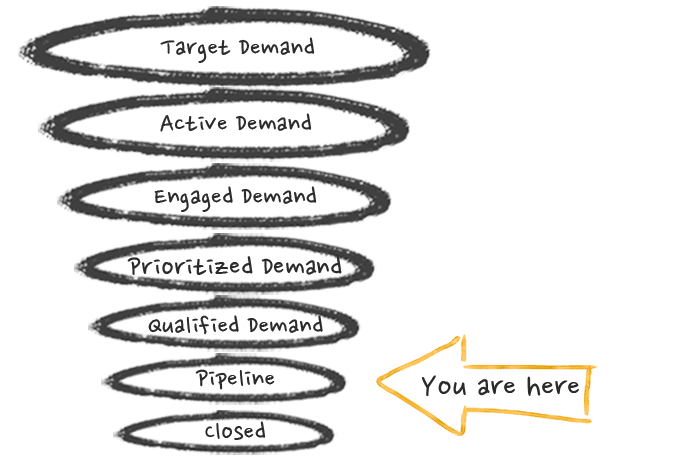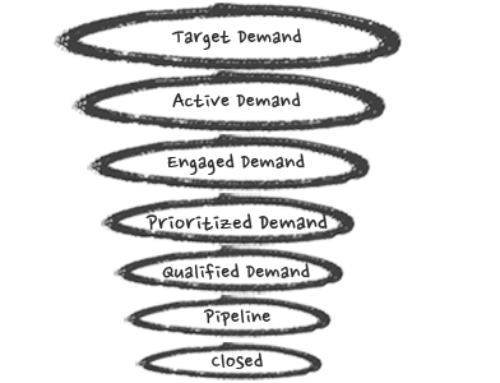
The principal objective in the Pipeline stage is to move accounts from an opportunity to close. This is best achieved through a direct interaction between sales and marketing, where marketing’s role is to provide the materials that prospects need to support their buying decision.
The Demand Unit Waterfall has seven stages where the Pipeline is set as a single stage. Since the Demand Unit Waterfall Pipeline stage encompasses the “sales pipeline,” it is a bit confusing. In practice, the sales pipeline will nearly always have its own sales stages set up in your sales automation system/CRM. You will need to include these sales pipeline stages in your buyer journey map so you can track and optimize your collateral around the materials most needed to close accounts with a sale (“closed won”).
While every company has its unique take on sales pipeline stages, typically they include stages for contact, presentation pitch, proposal review, contract, and close.

As illustrated above, the Demand Unit Waterfall has only a single pipeline stage while a sales pipeline can have several or many stages. In this example, there are 5 sales pipeline stages. The Close stage is the same in both.
Stumbling blocks
Having a clear view of the buyer’s journey and materials needed to support it. While buyer’s journeys by their nature are generic and will rarely apply to every customer, it is still important to define the journey as it provides a road map from which sales and marketing have a common language, one where the marketing team can produce collateral to support different points along the journey.
For example, let’s say that it is common for purchasers of your products or services to require top-level executive or board approval. To address that need, the marketing team would produce an easy-to-customize PowerPoint deck that could be handed over to the prospect to use as a baseline for their presentation. Not only would the salesperson be seen as consultative in the sales process, but it would also give your company an opportunity to frame the presentation in a way that puts your product or service in its best light.
Only through building a buyer’s journey would you discover that most of your prospects need to be making a presentation like this internally.
Over the transom sales requests. As deals heat up, prospects will ask the salesperson for documents, case studies, customer references, and various other materials, some of which you will already have, others you will not. On the one hand, if there is something that needs to be produced that will provide future benefits to many accounts, then you will want to offer it. On the other hand, there are many requests for materials that are likely one-offs which can help close a specific sale but have little value more broadly.
Very few marketing organizations have the budget or bandwidth to create 1:1 marketing materials for every deal in the pipeline, yet this is one of the most significant areas of tension between sales and marketing, especially at a month, quarter, or year-end when the sales team is under tremendous pressure to close deals.
Your best option for dealing with this is to work with your sales management team directly so you can develop a process that will cover how sales and marketing jointly evaluate these requests. By pulling sales management into the prioritization of your resources, you will have better alignment on the outcomes. It also provides an incentive for the sales managers to evaluate whether a request for new collateral is an objection in disguise and to address that more directly.
Preparing for success
At this Pipeline stage of the Waterfall, your primary tool will be your sales automation platform or customer relationship management system (CRM). As with the case in the Qualified Demand stage, it is critical that everyone on the sales team use the CRM to document every prospect interaction. While typically a sales management function, usage of the CRM should be audited by the marketing team regularly for compliance, as it is impossible to analyze collateral performance data that has not been captured.
Buyer’s journey definition. Your buyer journey should include the needs and behavior of each person in the Demand Unit once they are in this pipeline stage. Understanding the buyer’s needs at this stage is critical for defining what marketing collateral you will need to provide or produce to help the sales team move prospects down the sales pipeline.
Emails. At this Pipeline stage, emails will generally be customized or semi-customized by salespeople, and you will not need to provide defined cadences. Since you will be creating various assets to help drive prospects down the sales pipeline, you will still want to build email templates with messaging for each of the assets you have created for this purpose. The salesperson can then integrate your language into their communications.
For example, case studies and customer testimonials are very popular at this stage, and you want to provide the sales team with an overview of what is available to them along with descriptions on how to use the assets and how to present them to prospects. In practice, this could be anything from a shared spreadsheet to a formal digital asset management system.
Account-based advertising. Now that accounts are in the sales pipeline do not let up on hitting the entire Demand Unit, ideally with ads that are targeted by job function that promote the consumption of materials customized for the interests of each of the Demand Unit stakeholders.
Account monitoring. While the formal account scoring used to decide when to hand an account over to sales has stopped (since the account is already in sales hands), the sales team should still be using the tracking features in your account scoring platform or marketing automation platform to monitor the activities of each account in their pipeline. After all, it is one thing to send the prospect an email with a link to a case study, and another to know the prospect has read the case study.
Being able to see prospects’ utilization of content, downloads, web pages, webinars and so forth, will provide the salesperson with a good idea of where the account is in its evaluation process and what the account is doing.
Account scoring and marketing automation systems can generally be set up to track prospect behavior and inform the salesperson of that behavior. Because of the value that derives from understanding this behavior in this Pipeline stage, you will want to work with your sales management and sales operations team to make sure that all the collateral sent to prospects is passed through links rather than directly attached to emails. The value of knowing that a piece of collateral has been consumed should be enough to ensure that this behavior is followed. There are also methods that can track download and consumption of email attachments, and if so, make sure that is all integrated into your systems in a way where you and the sales team can track and be notified of behavior.
Team
There is no other stage in the Demand Unit Waterfall which requires as much close and careful interaction between sales and marketing than this stage. You will generally get the most leverage from your marketing resources when placed here; after all a small increase in the closed-won percentage is the equivalent to a lot of spend higher up the Waterfall.
The critical ingredient for sales and marketing working in harmony is communication and alignment on a process that both teams will follow. Call it rules-of-engagement. Without rules-of-engagement, there is much finger-pointing.
Take a pragmatic approach here. Get everyone to align with your buyer’s journey and the collateral it implies. Set up a regular cadence of meetings where you sit down with sales management and review how the marketing assets are performing and what should be added, improved upon, or tested.
Send a marketing representative to sales pipeline review meetings to get qualitative data on what the sales pipeline challenges are and what they are hearing from accounts as this is valuable information to help you improve on your go-to-market efforts up-and-down the Waterfall.
Deliverables
Sales collateral might include:
- ROI calculator
- Proposal templates
- Presentation decks
- Case studies
- Testimonials
- Email templates to accompany collateral
- Ads/landing pages for account-based advertising and/or retargeting campaigns so that you can keep your product and company front-of-mind in the accounts the sales teams are working to close
Measuring success
The principal KPI is closed accounts, split out into closed-won and closed-lost.
There are several supporting metrics to track:
- Days to close, segmented by closed-won and closed-lost
- Average deal size, segmented by closed-won and closed-lost (closed-lost accounts will have had an estimate of the value of the opportunity).
- Days in each stage of the sales pipeline, which can be helpful to understand any holes in the collateral. Wherever accounts seem to go dark in the sales pipeline for longer than they should, that should be the area of focus testing and optimization.
You will also want to measure the engagement level of the collateral pieces that you’re producing. You are almost guaranteed to be surprised that certain materials are being consumed at a higher level than you would expect and vice-versa. Scrutinize this data and ask yourself where your assumptions are wrong, where they are right, and what those implications are for evolving the buyer journey and its accompanying collateral that you have produced and need to create in the future.



